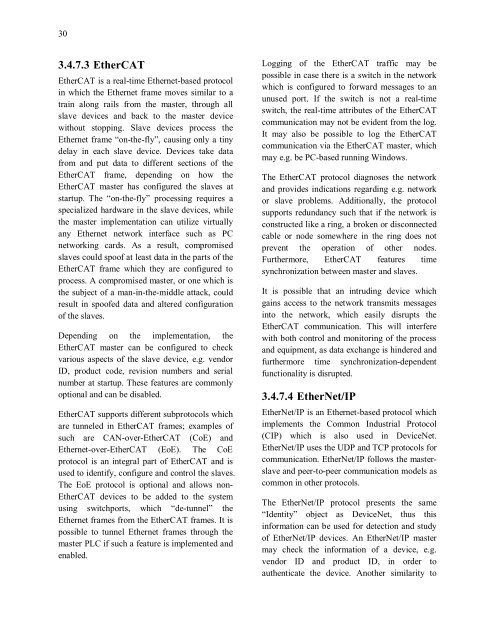white paper on industrial automation security in fieldbus and
white paper on industrial automation security in fieldbus and
white paper on industrial automation security in fieldbus and
Create successful ePaper yourself
Turn your PDF publications into a flip-book with our unique Google optimized e-Paper software.
303.4.7.3 EtherCATEtherCAT is a real-time Ethernet-based protocol<strong>in</strong> which the Ethernet frame moves similar to atra<strong>in</strong> al<strong>on</strong>g rails from the master, through allslave devices <strong>and</strong> back to the master devicewithout stopp<strong>in</strong>g. Slave devices process theEthernet frame “<strong>on</strong>-the-fly”, caus<strong>in</strong>g <strong>on</strong>ly a t<strong>in</strong>ydelay <strong>in</strong> each slave device. Devices take datafrom <strong>and</strong> put data to different secti<strong>on</strong>s of theEtherCAT frame, depend<strong>in</strong>g <strong>on</strong> how theEtherCAT master has c<strong>on</strong>figured the slaves atstartup. The “<strong>on</strong>-the-fly” process<strong>in</strong>g requires aspecialized hardware <strong>in</strong> the slave devices, whilethe master implementati<strong>on</strong> can utilize virtuallyany Ethernet network <strong>in</strong>terface such as PCnetwork<strong>in</strong>g cards. As a result, compromisedslaves could spoof at least data <strong>in</strong> the parts of theEtherCAT frame which they are c<strong>on</strong>figured toprocess. A compromised master, or <strong>on</strong>e which isthe subject of a man-<strong>in</strong>-the-middle attack, couldresult <strong>in</strong> spoofed data <strong>and</strong> altered c<strong>on</strong>figurati<strong>on</strong>of the slaves.Depend<strong>in</strong>g <strong>on</strong> the implementati<strong>on</strong>, theEtherCAT master can be c<strong>on</strong>figured to checkvarious aspects of the slave device, e.g. vendorID, product code, revisi<strong>on</strong> numbers <strong>and</strong> serialnumber at startup. These features are comm<strong>on</strong>lyopti<strong>on</strong>al <strong>and</strong> can be disabled.EtherCAT supports different subprotocols whichare tunneled <strong>in</strong> EtherCAT frames; examples ofsuch are CAN-over-EtherCAT (CoE) <strong>and</strong>Ethernet-over-EtherCAT (EoE). The CoEprotocol is an <strong>in</strong>tegral part of EtherCAT <strong>and</strong> isused to identify, c<strong>on</strong>figure <strong>and</strong> c<strong>on</strong>trol the slaves.The EoE protocol is opti<strong>on</strong>al <strong>and</strong> allows n<strong>on</strong>-EtherCAT devices to be added to the systemus<strong>in</strong>g switchports, which “de-tunnel” theEthernet frames from the EtherCAT frames. It ispossible to tunnel Ethernet frames through themaster PLC if such a feature is implemented <strong>and</strong>enabled.Logg<strong>in</strong>g of the EtherCAT traffic may bepossible <strong>in</strong> case there is a switch <strong>in</strong> the networkwhich is c<strong>on</strong>figured to forward messages to anunused port. If the switch is not a real-timeswitch, the real-time attributes of the EtherCATcommunicati<strong>on</strong> may not be evident from the log.It may also be possible to log the EtherCATcommunicati<strong>on</strong> via the EtherCAT master, whichmay e.g. be PC-based runn<strong>in</strong>g W<strong>in</strong>dows.The EtherCAT protocol diagnoses the network<strong>and</strong> provides <strong>in</strong>dicati<strong>on</strong>s regard<strong>in</strong>g e.g. networkor slave problems. Additi<strong>on</strong>ally, the protocolsupports redundancy such that if the network isc<strong>on</strong>structed like a r<strong>in</strong>g, a broken or disc<strong>on</strong>nectedcable or node somewhere <strong>in</strong> the r<strong>in</strong>g does notprevent the operati<strong>on</strong> of other nodes.Furthermore, EtherCAT features timesynchr<strong>on</strong>izati<strong>on</strong> between master <strong>and</strong> slaves.It is possible that an <strong>in</strong>trud<strong>in</strong>g device whichga<strong>in</strong>s access to the network transmits messages<strong>in</strong>to the network, which easily disrupts theEtherCAT communicati<strong>on</strong>. This will <strong>in</strong>terferewith both c<strong>on</strong>trol <strong>and</strong> m<strong>on</strong>itor<strong>in</strong>g of the process<strong>and</strong> equipment, as data exchange is h<strong>in</strong>dered <strong>and</strong>furthermore time synchr<strong>on</strong>izati<strong>on</strong>-dependentfuncti<strong>on</strong>ality is disrupted.3.4.7.4 EtherNet/IPEtherNet/IP is an Ethernet-based protocol whichimplements the Comm<strong>on</strong> Industrial Protocol(CIP) which is also used <strong>in</strong> DeviceNet.EtherNet/IP uses the UDP <strong>and</strong> TCP protocols forcommunicati<strong>on</strong>. EtherNet/IP follows the masterslave<strong>and</strong> peer-to-peer communicati<strong>on</strong> models ascomm<strong>on</strong> <strong>in</strong> other protocols.The EtherNet/IP protocol presents the same“Identity” object as DeviceNet, thus this<strong>in</strong>formati<strong>on</strong> can be used for detecti<strong>on</strong> <strong>and</strong> studyof EtherNet/IP devices. An EtherNet/IP mastermay check the <strong>in</strong>formati<strong>on</strong> of a device, e.g.vendor ID <strong>and</strong> product ID, <strong>in</strong> order toauthenticate the device. Another similarity to
















